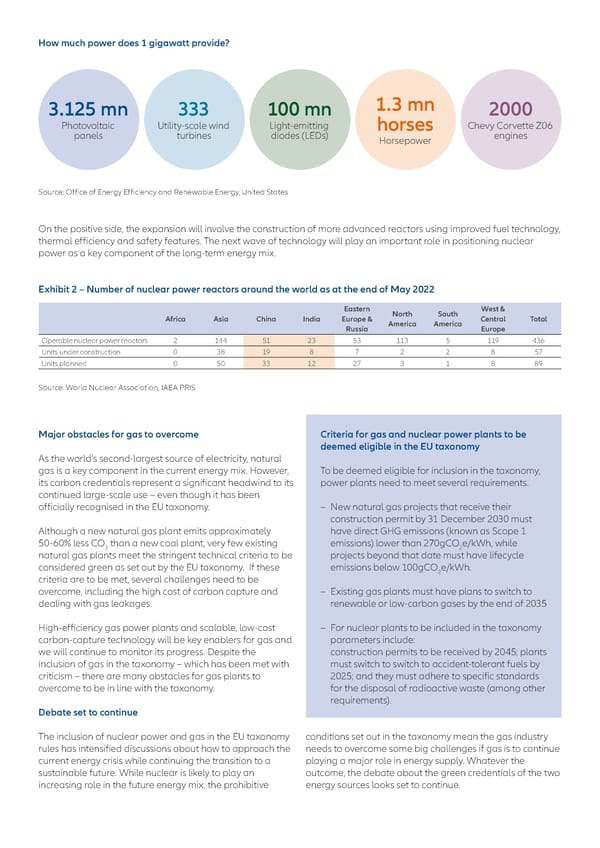How much power does 1 gigawatt provide? 3.125 mn 333 100 mn 1.3 mn 2000 Photovoltaic Utility-scale wind Light-emitting horses Chevy Corvette Z06 panels turbines diodes (LEDs) Horsepower engines Source: Office of Energy Efficiency and Renewable Energy, United States On the positive side, the expansion will involve the construction of more advanced reactors using improved fuel technology, thermal efficiency and safety features. The next wave of technology will play an important role in positioning nuclear power as a key component of the long-term energy mix. Exhibit 2 – Number of nuclear power reactors around the world as at the end of May 2022 Eastern North South West & Africa Asia China India Europe & America America Central Total Russia Europe Operable nuclear power reactors 2 144 51 23 53 113 5 119 436 Units under construction 0 38 19 8 7 2 2 8 57 Units planned 0 50 33 12 27 3 1 8 89 Source: World Nuclear Association, IAEA PRIS Major obstacles for gas to overcome Criteria for gas and nuclear power plants to be deemed eligible in the EU taxonomy As the world’s second-largest source of electricity, natural gas is a key component in the current energy mix. However, To be deemed eligible for inclusion in the taxonomy, its carbon credentials represent a significant headwind to its power plants need to meet several requirements. continued large-scale use – even though it has been officially recognised in the EU taxonomy. – N ew natural gas projects that receive their construction permit by 31 December 2030 must Although a new natural gas plant emits approximately have direct GHG emissions (known as Scope 1 50-60% less CO than a new coal plant, very few existing emissions) lower than 270gCO e/kWh, while 2 2 natural gas plants meet the stringent technical criteria to be projects beyond that date must have lifecycle considered green as set out by the EU taxonomy. If these emissions below 100gCO e/kWh. criteria are to be met, several challenges need to be 2 overcome, including the high cost of carbon capture and – E xisting gas plants must have plans to switch to dealing with gas leakages. renewable or low-carbon gases by the end of 2035 High-efficiency gas power plants and scalable, low-cost – F or nuclear plants to be included in the taxonomy carbon-capture technology will be key enablers for gas and parameters include: we will continue to monitor its progress. Despite the construction permits to be received by 2045; plants inclusion of gas in the taxonomy – which has been met with must switch to switch to accident-tolerant fuels by criticism – there are many obstacles for gas plants to 2025; and they must adhere to specific standards overcome to be in line with the taxonomy. for the disposal of radioactive waste (among other requirements). Debate set to continue The inclusion of nuclear power and gas in the EU taxonomy conditions set out in the taxonomy mean the gas industry rules has intensified discussions about how to approach the needs to overcome some big challenges if gas is to continue current energy crisis while continuing the transition to a playing a major role in energy supply. Whatever the sustainable future. While nuclear is likely to play an outcome, the debate about the green credentials of the two increasing role in the future energy mix, the prohibitive energy sources looks set to continue.
 Nuclear and gas in the EU taxonomy: what this means for the energy mix of tomorrow Page 2 Page 4
Nuclear and gas in the EU taxonomy: what this means for the energy mix of tomorrow Page 2 Page 4